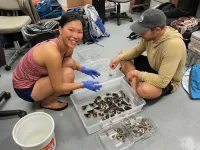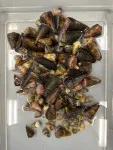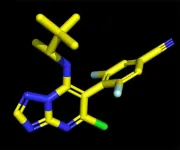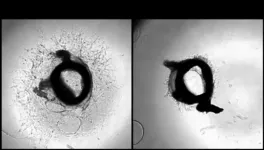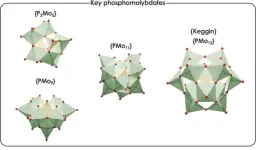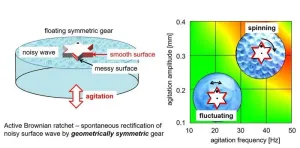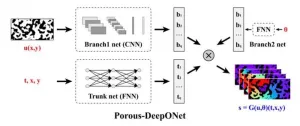(Press-News.org) Scientists are finding clues for how to treat diabetes and hormone disorders in an unexpected place: a toxin from one of the most venomous animals on the planet.
A multinational research team led by University of Utah scientists has identified a component within the venom of a deadly marine cone snail, the geography cone, that mimics a human hormone called somatostatin, which regulates the levels of blood sugar and various hormones in the body. The hormone-like toxin’s specific, long-lasting effects, which help the snail hunt its prey, could also help scientists design better drugs for people with diabetes or hormone disorders, conditions that can be serious and sometimes fatal.
The results published in the peer-reviewed journal Nature Communications on August 20, 2024.
A blueprint for better drugs
The somatostatin-like toxin the researchers characterized could hold the key to improving medications for people with diabetes and hormone disorders.
Somatostatin acts like a brake pedal for many processes in the human body, preventing the levels of blood sugar, various hormones, and many other important molecules from rising dangerously high. The cone snail toxin, called consomatin, works similarly, the researchers found—but consomatin is more stable and specific than the human hormone, which makes it a promising blueprint for drug design.
By measuring how consomatin interacts with somatostatin’s targets in human cells in a dish, the researchers found that consomatin interacts with one of the same proteins that somatostatin does. But while somatostatin directly interacts with several proteins, consomatin only interacts with one. This fine-tuned targeting means that the cone snail toxin affects hormone levels and blood sugar levels but not the levels of many other molecules.
In fact, the cone snail toxin is more precisely targeted than the most specific synthetic drugs designed to regulate hormone levels, such as drugs that regulate growth hormone. Such drugs are an important therapy for people whose bodies overproduce growth hormone. Consomatin’s effects on blood sugar could make it dangerous to use as a therapeutic, but by studying its structure, researchers could start to design drugs for endocrine disorders that have fewer side effects.
Consomatin is more specific than top-of-the-line synthetic drugs—and it also lasts far longer in the body than the human hormone, thanks to the inclusion of an unusual amino acid that makes it difficult to break down. This is a useful feature for pharmaceutical researchers looking for ways to make drugs that will have long-lasting benefits.
Learning from cone snails
Finding better drugs by studying deadly venoms may seem unintuitive, but Helena Safavi, PhD, associate professor of biochemistry in the Spencer Fox Eccles School of Medicine (SFESOM) at the University of Utah and the senior author on the study, explains that the toxins’ lethality is often aided by pinpoint targeting of specific molecules in the victim’s body. That same precision can be extraordinarily useful when treating disease.
“Venomous animals have, through evolution, fine-tuned venom components to hit a particular target in the prey and disrupt it,” Safavi says. “If you take one individual component out of the venom mixture and look at how it disrupts normal physiology, that pathway is often really relevant in disease.” For medicinal chemists, “it’s a bit of a shortcut.”
Consomatin shares an evolutionary lineage with somatostatin, but over millions of years of evolution, the cone snail turned its own hormone into a weapon.
For the cone snail’s fishy prey, consomatin’s deadly effects hinge on its ability to prevent blood sugar levels from rising. And importantly, consomatin doesn’t work alone. Safavi’s team had previously found that cone snail venom includes another toxin which resembles insulin, lowering the level of blood sugar so quickly that the cone snail’s prey becomes nonresponsive. Then, consomatin keeps blood sugar levels from recovering.
“We think the cone snail developed this highly selective toxin to work together with the insulin-like toxin to bring down blood glucose to a really low level,” says Ho Yan Yeung, PhD, a postdoctoral researcher in biochemistry in SFESOM and the first author on the study.
The fact that multiple parts of the cone snail’s venom target blood sugar regulation hints that the venom could include many other molecules that do similar things. “It means that there might not only be insulin and somatostatin-like toxins in the venom,” Yeung says. “There could potentially be other toxins that have glucose-regulating properties too.” Such toxins could be used to design better diabetes medications.
It may seem surprising that a snail is able to outperform the best human chemists at drug design, but Safavi says that the cone snails have evolutionary time on their side. “We’ve been trying to do medicinal chemistry and drug development for a few hundred years, sometimes badly,” she says. “Cone snails have had a lot of time to do it really well.”
Or, as Yeung puts it, “Cone snails are just really good chemists.”
###
This research published in Nature Communications on August 20, 2024, as "Disruption of Glucose Homeostasis in Prey: Combinatorial Use of Weaponized Mimetics of Somatostatin and Insulin by a Fish-Hunting Cone Snail."
Research reported in this press release was supported by the National Institute of General Medical Sciences of the National Institutes of Health under award number R01GM144719-03. The content is solely the responsibility of the authors and does not necessarily represent the official views of the National Institutes of Health. This research was also supported by a Villum Young Investigator Grant (19063), a Starting Grant from the European Commission (ERC-Stg 949830), and the Carlsberg Foundation (CF20-0248).
END
Deadly sea snail toxin could be key to making better medicines
2024-08-20
ELSE PRESS RELEASES FROM THIS DATE:
Planets contain more water than thought
2024-08-20
We know that the Earth has an iron core surrounded by a mantle of silicate bedrock and water (oceans) on its surface. Science has used this simple planet model until today for investigating exoplanets – planets that orbit another star outside our solar system. “It is only in recent years that we have begun to realise that planets are more complex than we had thought,” says Caroline Dorn, Professor for Exoplanets at ETH Zurich.
Most of the exoplanets known today are located close to ...
Blood platelet score detects previously unmeasured risk of heart attack and stroke
2024-08-20
Platelets are circulating cell fragments known to clump up and form blood clots that stop bleeding in injured vessels. Cardiologists have long known that platelets can become “hyperreactive” to cause abnormal clotting that blocks arteries and contributes to heart attack, stroke, and poor blood flow (peripheral artery disease) in the legs of millions of Americans.
Despite this major contribution to cardiovascular risk, routine measurement of whether each patient’s platelets clump (aggregate) too much has been infeasible to date. ...
New international Pioneer Centre for medical data research
2024-08-20
Can research on diseases as diverse as, for example, diabetes, cardiovascular diseases, psychiatric disorders and endometriosis be linked? The answer is yes if the research focuses on collecting and analysing large amounts of data from both Danish and international registers and biobanks to learn more about, among other things, risk factors, relationships, patterns, treatment and consequences.
And this is exactly what a new international Pioneer Centre, The Pioneer Centre for SMARTbiomed (Statistical and Computational Methods for Advanced Research ...
NIH awards $6.9 million to advance potential Alzheimer’s disease treatment
2024-08-20
A multidisciplinary team of scientists led by Carlo Ballatore, Ph.D., at University of California San Diego and Kurt Brunden, Ph.D., at the University of Pennsylvania has been awarded a $6.9 million grant from the National Institute on Aging (NIA) to prepare a potential disease-modifying Alzheimer’s treatment for future clinical trials. In a recently published study about the new compound, called CNDR-51997, the team found it was effective in restoring brain health in mouse models of Alzheimer's disease. CNDR-51997 was identified through a joint drug discovery program at Penn and UC San Diego that was supported by grants from the NIA.
The ...
iSN04: A novel nucleic acid drug for the treatment of vascular diseases
2024-08-20
Atherosclerosis, a major cause of mortality worldwide, involves an overgrowth of vascular smooth muscle cells in the blood vessels, constraining blood flow and potentially causing cardiovascular diseases. Against this backdrop, researchers from Shinshu University recently developed a DNA aptamer called iSN04 that targets and counteracts with the protein nucleolin in smooth muscle cells. This anti-nucleolin aptamer helps maintain smooth muscle cells in a differentiated state, offering new treatment potential for atherosclerosis and other vascular ...
New computational methodology to predict the complex formation of interesting nanostructures
2024-08-20
Researchers from the group of Prof. Carles Bo, at the Institute of Chemical Research of Catalonia (ICIQ-CERCA), have described a computational methodology that simulates complex processes involving different chemical species and diverse conditions. These processes lead to the formation of nanostructures called polyoxometalates (POMs), with important applications in catalysis, energy storage, biology and medicine.
"Our group has recently developed unique methods to study the chemistry of polyoxometalates in solution, their speciation and formation ...
Novel ratchet with geometrically symmetric gear driven by asymmetric surface wettability
2024-08-20
The ratchet mechanism is a fascinating energy-conversion system that converts disorderly or random motion into orderly, directed movement through a process known as spontaneous rectification. It is a critical component of mechanical systems, typically consisting of a gear and a pawl, which restricts the movement of the gear in one direction. In biological systems, the concept of a Brownian ratchet has been proposed to help understand the mechanism of molecular motors, where chemical reactions rectify the random thermal motion of molecules.
According to the second law of thermodynamics, uniform thermal ...
Porous-DeepONet: A deep learning framework for efficiently solving reaction-transport equations in porous media
2024-08-20
Porous media play a critical role in various industrial fields due to their complex pore networks and considerable specific surface areas. The transport and reaction phenomena within porous media are key factors influencing fundamental parameters such as energy storage efficiency, catalytic performance, and adsorption rates. To accurately describe these complex transport and reaction processes, solving parameterized partial differential equations (PDEs) is necessary. However, due to the complex structure of porous media, traditional methods, such as the finite element method ...
Association for Molecular Pathology files lawsuit against FDA to challenge final rule on regulation for laboratory developed testing procedures
2024-08-20
ROCKVILLE, Md. – August 19, 2024 – The Association for Molecular Pathology (AMP), the premier global molecular diagnostic professional society, and world-renowned pathologist Michael Laposata, MD, PhD, today announced the filing of a lawsuit challenging the recent U.S. Food and Drug Administration (FDA) Rule that regulates laboratory developed test (LDT) procedures as medical devices under the Federal Food, Drug, and Cosmetic Act. The lawsuit was filed in the U.S. District Court for the Southern District of Texas against the FDA; Robert M. Califf, MD, in his official capacity as Commissioner of Food and Drugs; the U.S. Department of Health ...
Using AI to find the polymers of the future
2024-08-20
Nylon, Teflon, Kevlar. These are just a few familiar polymers — large-molecule chemical compounds — that have changed the world. From Teflon-coated frying pans to 3D printing, polymers are vital to creating the systems that make the world function better.
Finding the next groundbreaking polymer is always a challenge, but now Georgia Tech researchers are using artificial intelligence (AI) to shape and transform the future of the field. Rampi Ramprasad’s group develops and adapts ...
